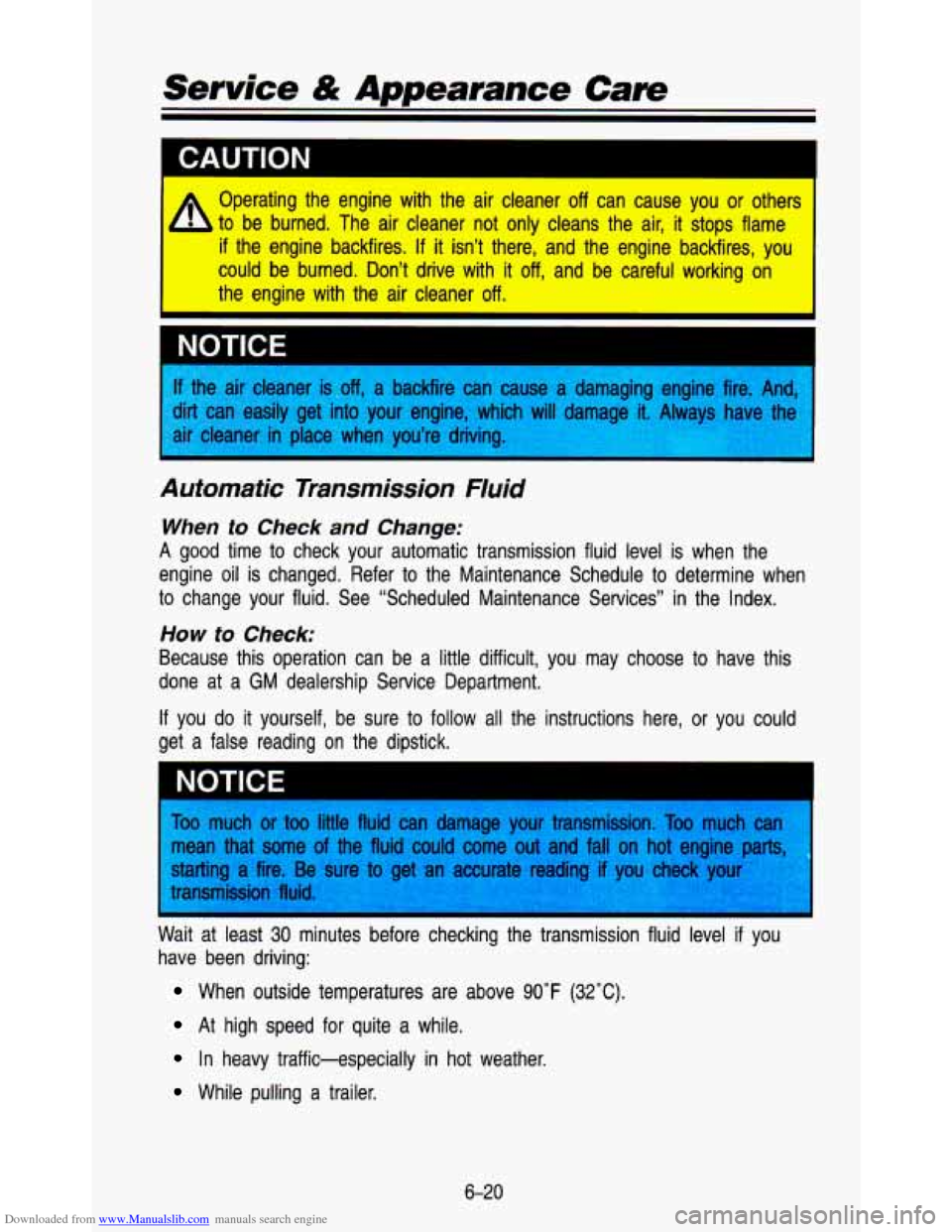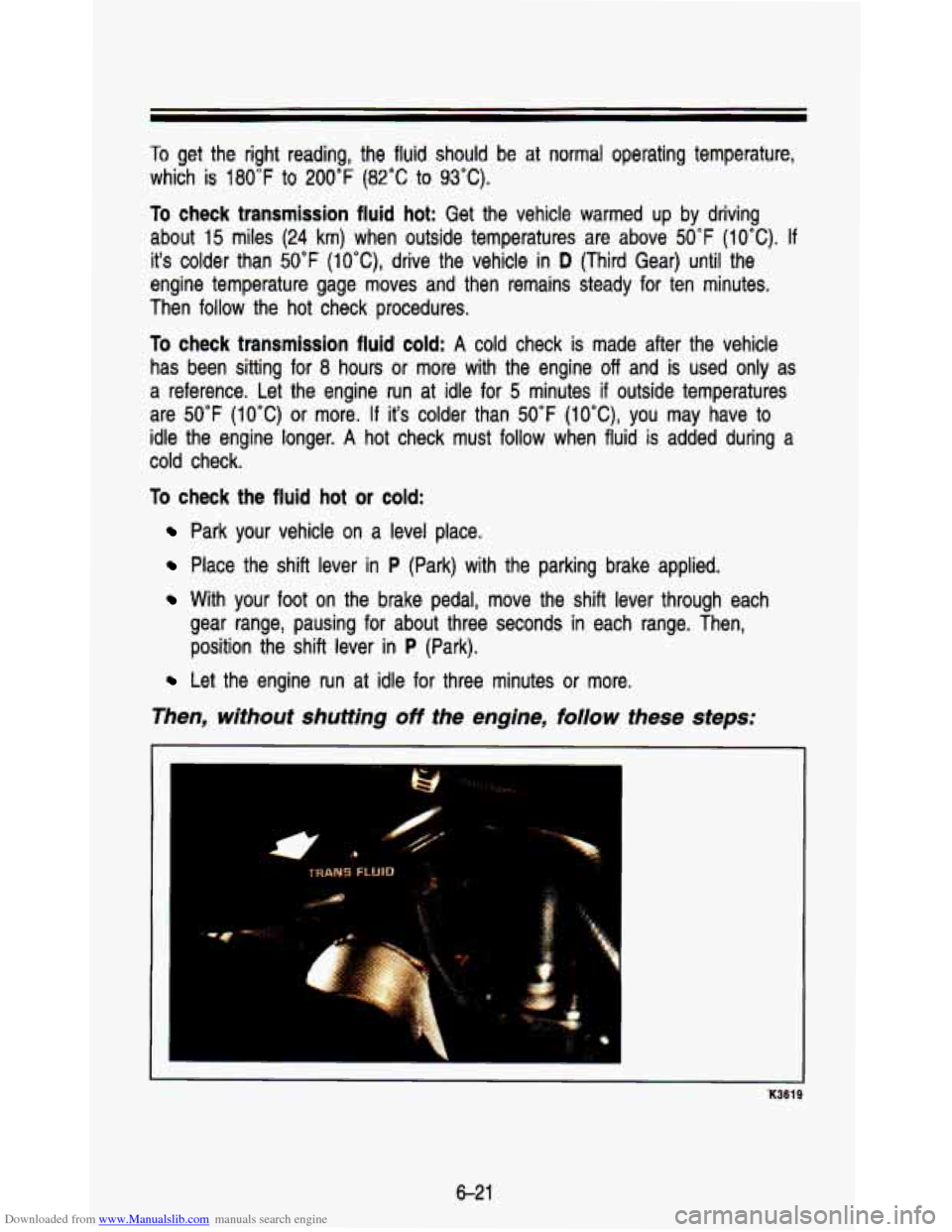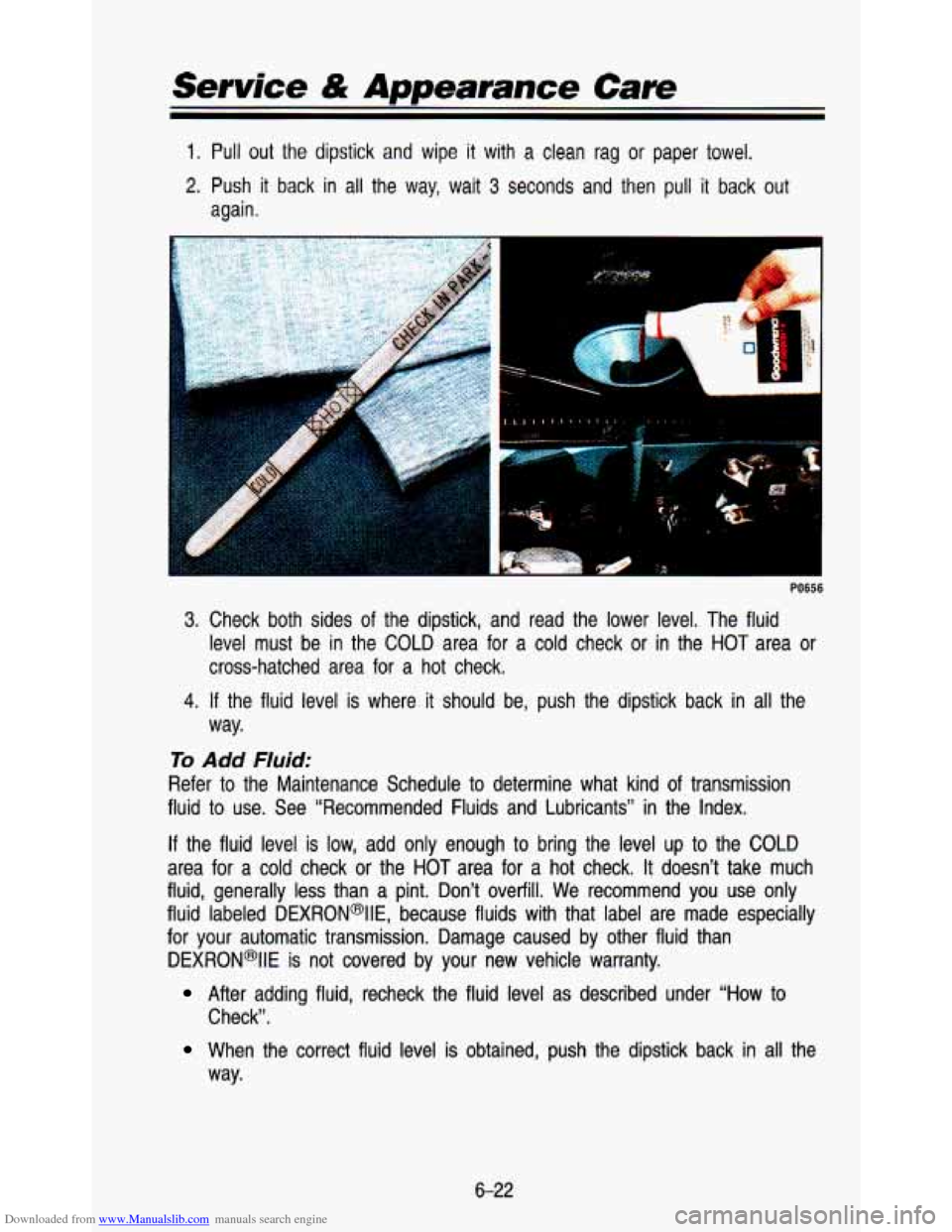Page 246 of 345
Downloaded from www.Manualslib.com manuals search engine Service dk Appearance Care
K3608
Turn off the engine and give the oil a few minutes to drain back down into
the oil pan.
If you don’t, the oil dipstick might not show the actual level\
.
To Check Engine Oil: Pull out the dipstick and clean it with a paper towel
or cloth, then push it back in all the way. Remove it again, keeping the tip
lower.
K3609
When to Add Oil: If the oil is at or below the ADD line, then you’ll need to
add some oil. But you must use the right kind. This section \
explains what
kind
of oil to use. For crankcase capacity see ‘Capacities and Speci\
fications’’
in the Index.
6-1 0
Page 256 of 345

Downloaded from www.Manualslib.com manuals search engine Service & Appearance Care
h
Operating the engine with the air cleaner off can cause you or other!
to be burned. The air cleaner not only cleans the air, it stops flame
if the engine backfires. If it isn’t there, and the engine backfires, you
could be burned. Don’t drive with it off, and be careful working on
the engine with the air cleaner off.
If the air cleaner is off, a backfir
dirt can easily get into your engine,
air cleaner in place when you’re drivin $use a damaging engir
hicl
vill damage it. Na)
Automatic Transmission Nuid
When to Check and Change:
A good time to check your automatic transmission fluid level is when the
engine oil is changed. Refer to the Maintenance Schedule
to determine when
to change your fluid. See “Scheduled Maintenance Services” in the Index.
How to Check:
Because this operation can be a little difficult, you may choo\
se to have this
done at a
GM dealership Service Department.
If you do it yourself, be sure to follow all the instructions here, or you could
get a false reading on the dipstick.
Too much or too little fluid can damage your transmission. Too much can
mean that some of the fluid could come out and fall on hot engine part-
starting a fire. Be sure to get an accurate reading
if you check your
transmission fluid.
I
I
Wait at least 30 minutes before checking the transmission fluid level if you
have been driving:
When outside temperatures are above 90°F (32°C).
At high speed for quite a while.
In heavy traffic-especially in hot weather.
While pulling a trailer.
6-20
Page 257 of 345

Downloaded from www.Manualslib.com manuals search engine To get the right reading, the fluid should be at normal operating temperature,
which is
180°F to 200°F (82°C to 93°C).
To check transmission fluid hot: Get the vehicle warmed up by driving
about
15 miles (24 km) when outside temperatures are above 50°F (10°C). If
it's colder than 50°F (lO'C), drive the vehicle in D (Third Gear) until the
engine temperature gage moves and then remains steady for ten \
minutes.
Then follow the hot check procedures.
To check transmission fluid cold: A cold check is made after the vehicle
has been sitting for
8 hours or more with the engine off and is used only as
a reference. Let the engine run at idle for
5 minutes if outside temperatures
are
50°F (1 0°C) or more. If it's colder than 50°F (lO"C), you may have to
idle the engine longer.
A hot check must follow when fluid is added during a
cold check.
To check the fluid hot or cold:
Park your vehicle on a level place.
Place the shift lever in P (Park) with the parking brake applied.
With your foot on the brake pedal, move the shift lever throu\
gh each
gear range, pausing for about three seconds in each range. Then,
position the shift lever in
P (Park).
Let the engine run at idle for three minutes or more.
Then, without shutting off the engine, follow these steps:
K3619
6-21
Page 258 of 345

Downloaded from www.Manualslib.com manuals search engine Service & Appearance Care
1. Pull out the dipstick and wipe it with a clean rag or paper towel.
2. Push it back in all the way, wait 3 seconds and then pull it back out
again.
3. Check both sides of the dipstick, and read the lower level. The fluid
level must be in the COLD area for a cold check or in the
HOT area or
cross-hatched area for a hot check.
way.
4. If the fluid level is where it should be, push the dipstick back in all the
To Add Fluid:
Refer to the Maintenance Schedule to determine what kind of transmission
fluid
to use. See “Recommended Fluids and Lubricants” in the Index.
If the fluid level is low, add only enough to bring the level up to the COLD
area
for a cold check or the HOT area for a hot check. It doesn’t take much
fluid, generally less than a pint. Don’t overfill. We recommend you use only
fluid labeled DEXRON@IIE, because fluids with that label are ma\
de especially
for your automatic transmission. Damage caused by other fluid t\
han DEXRON*IIE
is not covered by your new vehicle warranty.
After adding fluid, recheck the fluid level as described under “How to
Check”.
When the correct fiuid level is obtained, push the dipstick back in all the
way.
6-22
Page 259 of 345
Downloaded from www.Manualslib.com manuals search engine Rear Axle
When to Check and Change Lubricant:
Refer to the Maintenance Schedule to determine how often to check the
lubricant and when to change it. See “Scheduled Maintenance Services” in
the Index.
How to Check Lubricant:
1
,. . ..
1
If the level is below the bottom of the filler plug hole, you’ll need to add
some lubricant.
Add enough lubricant to raise the level to the bottom of the
filler plug hole.
What to Use:
Refer to the Maintenance Schedule to determine what kind of lubricant to
use. See ”Recommended Fluids and Lubricants” in the Index.
All= Wheel Drive
If you have an all-wheel drive vehicle, be sure to perform the lubricant
checks described in this section. However, they have two additional systems
that need lubrication.
Transfer Case
When to Check Lubricant:
Refer to the Maintenance Schedule to determine how often to check the
lubricant. See “Periodic Maintenance Inspections” in the Index.
6-23
Page 260 of 345
Downloaded from www.Manualslib.com manuals search engine How to Check Lubricant:
J
K3170
If the level is below the bottom of the filler plug hole, you’ll need to add
some lubricant. Add enough lubricant to raise the level to the bottom of the
filler plug hole.
What to Use:
Refer to the Maintenance Schedule to determine what kind of lubricant to
use. See ”Recommended Fluids and Lubricants” in the Index.\
Front Axle
When to Check and Change Lubricant:
Refer to the Maintenance Schedule to determine how often to check the
lubricant and when to change it. See “Scheduled Maintenance Services” in
the Index.
6-24
Page 261 of 345
Downloaded from www.Manualslib.com manuals search engine How to Check Lubricant:
r
KO998
If the level is below the bottom of the filler plug hole, you’ll need to add
some lubricant.
Add enough lubricant to raise the level to the bottom of the
filler plug hole.
What to Use:
Refer to the Maintenance Schedule to determine what kind of lubricant to
use. See “Recommended Fluids and Lubricants” in the Index.
6-25
Page 263 of 345
Downloaded from www.Manualslib.com manuals search engine If you have to add coolant more than four times a year, have your dealer
check your cooling system.
I
If you use the proper coolant, you don’t have to add extra inhibitors or
additives which claim to improve the system. These can
be harm1
6-27